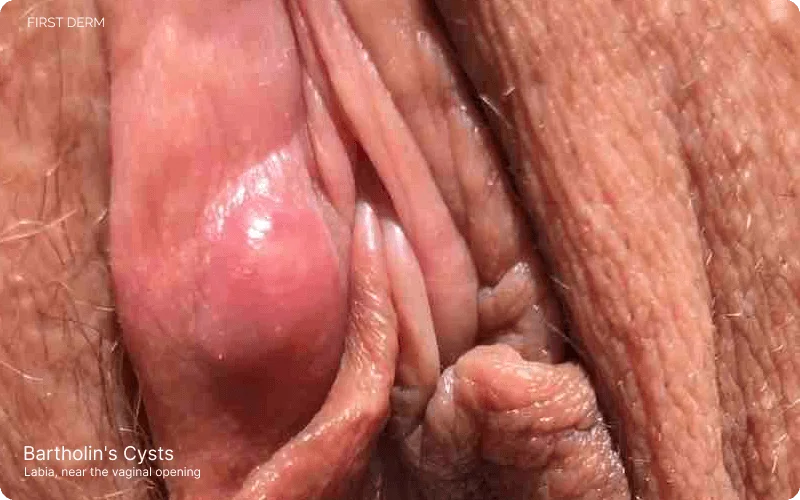Bartholin’s Cyst: Pictures, Symptoms, Diagnosis & Treatment

Key Takeaways
- Bartholin’s Glands: Located at the vaginal opening, these glands produce fluid for lubrication.
- Causes of Cysts: Fluid backup due to blocked gland ducts, often caused by infection or injury, leads to cyst formation.
- Symptoms and Detection: Small cysts may go unnoticed, while larger or infected ones cause lumps, discomfort, and pain.
- Treatment Options: Treatments range from sitz baths for minor cases to surgical drainage for larger or infected cysts, with antibiotics for infections.
- Risk of Infection: An infected cyst can rapidly turn into an abscess, necessitating prompt medical attention.
-
Prevention and Recurrence: While complete prevention is not possible, safer sex and hygiene can reduce infection risks. Recurrences of cysts or abscesses may require additional treatment.
Bartholin’s glands, though often unnoticed, play a significant role in vaginal health by producing lubricating fluids. However, when these glands encounter obstructions, they can give rise to Bartholin’s cysts, resulting in swelling and discomfort near the vaginal opening.
Failure to address these cysts promptly can lead to the development of abscesses, causing intense pain and potential complications.
What Are Bartholin’s Cysts?
Bartholin’s Glands and Mechanism of Cyst Formation
- Bartholin’s Glands: Situated on each side of the vaginal opening, Bartholin’s glands are responsible for secreting fluid that aids in vaginal lubrication during sexual activity. These small glands play a vital role in maintaining vaginal moisture and overall vaginal health.
- Cyst Formation: Bartholin’s cysts develop when the ducts of these glands become blocked, leading to the accumulation of fluid. This blockage can occur due to various factors such as infections, inflammation, or trauma. As the fluid collects within the gland, a cyst forms, causing a painless lump near the vaginal opening.[1]
Differences Between a Cyst and an Abscess
- Cyst: A Bartholin’s cyst is typically a painless swelling caused by the accumulation of fluid within the gland. It may gradually increase in size and can be felt as a lump near the vaginal opening. Cysts are usually non-infected and may not cause significant discomfort initially.
- Abscess: In contrast, an abscess occurs when a cyst becomes infected. This infection leads to the formation of pus within the cyst, resulting in pain, swelling, redness, and tenderness in the affected area. Abscesses are often accompanied by symptoms of infection such as fever and general malaise.
Symptoms of Bartholin’s Cysts and Abscesses
Symptoms of Non-Infected Bartholin’s Cysts
- Presence of a painless lump near the vaginal opening.
- Discomfort during intercourse.
- Swelling in the genital area.
- Possible redness or tenderness around the cyst.
Infected Bartholin’s Abscesses

Bartholin’s cyst abscess on the lower side of the labia near the vaginal opening, showing swelling due to the accumulation of pus
- Pain, swelling, and tenderness near the vaginal opening.
- Redness and warmth in the affected area.
- Development of a visible pus-filled lump.
- Fever and general malaise indicating infection.[2]
When to Seek Medical Attention Bartholin’s Cysts and Abscesses
Age Considerations
- Women of all ages should seek medical advice if symptoms are present.
- Older women may have an increased risk of complications and should be particularly vigilant.
Importance of Excluding Serious Conditions:
- Prompt medical attention is crucial to rule out more serious conditions that may present with similar symptoms.
- Any sudden or severe symptoms, especially in postmenopausal women, should be evaluated promptly.
Bartholin’s Cysts: Causes and Risk Factors
Potential Causes
- Infections: Infections play a significant role in causing blockages in the ducts of Bartholin’s glands, leading to the formation of cysts. Bacterial infections, sexually transmitted infections, or other microbial agents can contribute to the development of these blockages.[3]
- Injury: Trauma or injury to the area around the Bartholin’s glands can also result in blockages, hindering the normal flow of fluid and causing cyst formation. Physical trauma during childbirth, accidents, or other injuries can be contributing factors.
Discussion of Risk Factors
- Sexual Activity: Increased sexual activity, especially with multiple partners or engaging in activities that may introduce bacteria into the genital area, can elevate the risk of developing Bartholin’s cysts.
- Previous Occurrences: Individuals who have had Bartholin’s cysts in the past are at a higher risk of experiencing recurrent episodes.[4] Proper management and preventive measures are crucial for reducing the likelihood of recurrence.
- Age-Specific Considerations: Age can also be a factor in the development of Bartholin’s cysts. Postmenopausal women may have different risk factors compared to younger women, emphasizing the importance of age-specific considerations in understanding and managing this condition.
Bartholin’s Cysts: Diagnosis Process
- Physical Examinations: Healthcare providers often begin the diagnostic process by conducting a physical examination of the affected area. This examination helps assess the size, location, and characteristics of the cyst or abscess.
- Possible Lab Tests: In some cases, healthcare professionals may recommend lab tests such as cultures to identify the specific bacteria causing an infection in the cyst or abscess. These tests can help guide treatment decisions.
- Role of Biopsy in Older Patients: For older patients or cases where there is uncertainty about the nature of the cyst or abscess, a biopsy may be performed. A biopsy involves taking a small tissue sample for further analysis to confirm the diagnosis.[4]
Importance of Differential Diagnosis
Rule Out Other Conditions: Differential diagnosis is crucial in the evaluation of Bartholin’s cysts to exclude other conditions that may present with similar symptoms, such as cancer. Healthcare providers may consider imaging studies or additional tests to rule out malignancies or other serious underlying issues.
Bartholin Cyst Treatment Options
Home Remedies
Home remedies like sitz baths, which involve soaking the affected area in warm water, can help alleviate discomfort and promote drainage of the cyst or abscess.
Medical Interventions
-
- Antibiotics: Prescribed to treat infections associated with Bartholin’s cysts or abscesses.
- Marsupialization: A surgical procedure that involves creating a permanent opening in the cyst to allow for drainage and prevent recurrence.[6]
- Gland Removal: In cases of recurrent or severe Bartholin’s cysts or abscesses, surgical removal of the Bartholin’s gland may be considered.
Decision-Making Process for Treatment
- Cyst Size: The size of the cyst or abscess may influence the choice of treatment, with larger cysts often requiring more aggressive interventions.
- Pain Level: The level of pain experienced by the individual can guide treatment decisions, with more painful cysts potentially necessitating immediate medical attention.
- Infection Status: The presence of infection in the cyst or abscess will determine the need for antibiotics or other antimicrobial treatments.
Special Considerations for Treatment in Postmenopausal Women
Hormonal Changes: Postmenopausal women may experience hormonal changes that can impact the development and management of Bartholin’s cysts. Healthcare providers may consider these factors when determining the most appropriate treatment approach for this demographic.
Preventive Measures and Managing Recurrences
- Safe Sex Practices: Practicing safe sex, including the use of condoms, can help reduce the risk of infections that may lead to Bartholin’s cysts. Maintaining good sexual hygiene is essential for overall vaginal health.[7]
- Hygiene: Maintaining proper hygiene in the genital area, including regular cleansing with mild soap and water, can help prevent infections and blockages in the Bartholin’s glands.
Recurrences and Long-Term Management
- Recurrence Expectations: Understanding that Bartholin’s cysts may recur is important. Individuals should be aware of the signs and symptoms of recurrence and seek medical advice promptly if they suspect a new cyst or abscess.
- Long-Term Management: Developing a long-term management plan with healthcare providers can help individuals navigate potential recurrences effectively. This may involve regular check-ups, monitoring symptoms, and adjusting treatment strategies as needed to prevent complications.
References
- Simmons BJ. Management of Bartholin’s duct cyst and gland abscess. American family physician. 2023;68 1:135-140. doi: https://doi.org/%22,
- Apoorvi Bharat Shah, Suresh Vasant Phatak, Pratap Singh Parihar, Lakshmi Bisnoi, Sai G. Infected Bartholin Cyst – Ultrasonography Doppler, Magnetic Resonance Evaluation. Journal of evolution of medical and dental sciences. 2021;10(18):1369-1371. doi: https://doi.org/10.14260/jemds/2021/289
- Daugherty JE. Bartholin Gland Cysts and Abscesses. Springer eBooks. Published online January 1, 2010:219-235. doi: https://doi.org/10.1007/978-0-387-76604-1_17
- Anozie OB, C. U. O. Esike, Anozie RO, E. Mamah, Eze JN, Onoh RC. Incidence, Presentation and Management of Bartholin’s Gland Cysts/Abscesses: A Four-Year Review in Federal Teaching Hospital, Abakaliki, South-East Nigeria. Open Journal of Obstetrics and Gynecology. 2016;06(05):299-305. doi: https://doi.org/10.4236/ojog.2016.65038
- Lee MY, Dalpiaz A, Schwamb R, Miao Y, Waltzer W, Khan A. Clinical Pathology of Bartholin’s Glands: A Review of the Literature. Current Urology. 2015;8(1):22-25. doi: https://doi.org/10.1159/000365683
- J. Pundir, Auld BJ. A review of the management of diseases of the Bartholin’s gland. Journal of Obstetrics and Gynaecology. 2008;28(2):161-165. doi: https://doi.org/10.1080/01443610801912865
- McNair R. Risks and prevention of sexually transmissible infections among women who have sex with women. Sexual Health. 2005;2(4):209-209. doi: https://doi.org/10.1071/sh04046
Ask a Dermatologist
Anonymous, fast and secure!

The Specialist doctor from the University Hospital in Gothenburg, alumnus UC Berkeley. My doctoral dissertation is about Digital Health and I have published 5 scientific articles in teledermatology and artificial intelligence and others.

